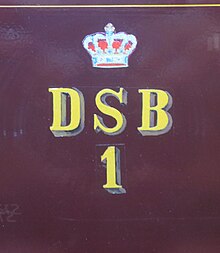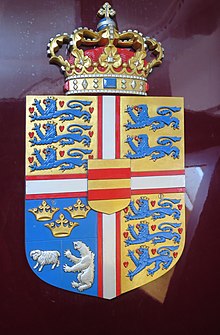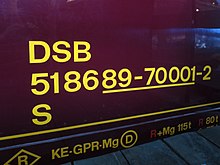DSB S (II) 1
| DSB S (II) 1 | |
|---|---|
|
Salon car in the Odense Museum
|
|
| Number: | 1 |
| Manufacturer: |
Scandia A / S , Randers Denmark |
| Year of construction (s): | 1937 |
| Retirement: | 2001 |
| Gauge : | 1435 mm ( standard gauge ) |
| Length over buffers: | 23.5 m |
| Width: | 2.85 m |
| Trunnion Distance: | 16.00 m |
| Bogie axle base: | 3.00 m |
| Empty mass: | 80 t |
| Top speed: | 120 km / h (160 km / h from 1984) |
| Seats: | 1 salon compartment, 6 sleeping compartments, 2 wet rooms |
The Danish DSB S (II) 1 entered service in 1937 as a saloon car for King Christian X. It is now in the Danish Railway Museum in Odense .
history
The predecessor vehicle, the royal saloon car Salonwagen S 8 , came from 1900, was technically obsolete at the end of the 1930s and should be replaced. The railroad enthusiast Crown Prince Frederik took part in the project in 1936 with a draft sketch, from which the final version deviated considerably. Queen Alexandrine exerted influence on the interior design . The car was built by Scandia A / S in Randers and entered service on September 22, 1937. After King Christian X it still served King Frederik IX. and Queen Margrethe II.
As early as September 26, 1937, King Christian IX. his new saloon car on the train with which the Storstrømsbrücke was inaugurated. He also drove to Cannes for the summer vacation until 1940 . And of course the car was carried on the train that transported the coffin with the king on April 30, 1947 for burial from Copenhagen to Roskilde . Frederik IX. then used the car until 1972 for official visits and holiday trips in Denmark and abroad. He also served foreign guests on state visits to Denmark for travels, including Emperor Haile Selassie of Ethiopia in 1954 and King Baudouin of Belgium in 1966. The car was also carried on the train that carried the coffin with the king on January 24, 1972 at the funeral of Copenhagen brought to Roskilde.
From the end of the 1970s, consideration was given to replacing the vehicle. There were also initial plans for this. However, the decision was made in favor of a general overhaul, which took place in 1983/84. This was necessary due to technical developments as well as the condition of the interior fittings, which are now almost 50 years old. The design of the new upholstery fabrics in the salon was made according to a design by Queen Margarethe. On May 31, 1984, the newly renovated car was used for the first time on a trip to Glamsbjerg by the Queen .
In 1985 the Queen Mother, Queen Ingrid , celebrated the 50th anniversary of her arrival in Denmark. To do this, she drove with the royal family in the saloon car from Helsingør to Gråsten , where Gråsten Castle is a royal residence. At her funeral, too, the car was placed on the special train that brought the coffin to Roskilde on November 14, 2000.
On December 14, 2001, Queen Margarethe II received a new salon car, which was built in 1987 as the DSB Ckm 601 conference car by Linke-Hofmann-Busch . This was converted into the DSB WRm 601 buffet car in 1991 . In 2001 it was rebuilt in Centralværkstedet København (Cvk Kh), so it met the increased technical requirements and can be used for speeds of up to 200 km / h.
The DSB 1 saloon car was handed over to the Danish Railway Museum. On the occasion of the handover, Queen Margaret II carved her name into the window of her former sleeping compartment.
vehicle
In contrast to the previous vehicle, the car is made entirely of steel. With a length of 23.5 m, it was the longest passenger car in the DSB fleet in 1937 . When the vehicle was refurbished in 1983/84, it was also given new chassis so that instead of the originally permitted maximum speed of 120 km / h, 160 km / h was now possible.
The car is painted in burgundy red, there are golden crowns on the doors and there was originally a Danish and an Icelandic coat of arms on the sides of the car . The latter was no longer used after Iceland became a republic in 1944.
There are closed entry platforms at both ends of the car. This is followed by the salon at one end via two window axes , which extends over the entire width of the car. Its equipment also includes a radio receiver . The other compartments are lined up along a side aisle. First of all, these are the sleeping compartments for the king and queen (or: the queen and the prince consort ). They shared a washroom with a toilet in between, which is accompanied by a second internal corridor that connects the two sleeping compartments. This group of rooms is followed by four half-compartments equipped for sleeping car compartments . This is followed by another washroom with a toilet and then a group of smaller rooms for heating, luggage, etc. and then the second entry room.
literature
- Labeling on the object in the Danish Railway Museum in Odense [2019].
- NN: Den nye Kongevogn . In: Trafik og Teknik 1937/38 (6), pp. 103-105.
- Poul Thestrup: Danske Kongevogne . Bane Boger, Roskilde 1992. ISBN 87 88632 39-3
Web link
- Information about the car on the website of the Danish Railway Museum, Odense; accessed on July 24, 2019
- DSB S (II). In: jernbanen.dk. (Danish).
- Conventional salons gennem mere end 160 år. In: kongehuset.dk. October 17, 2018, accessed July 31, 2019 (Danish).
Remarks
- ↑ Part of the Danish court ceremony is that deceased monarchs are transported by special train from Copenhagen to Roskilde, where they traditionally find their final resting place in the local cathedral . The currently used royal saloon car for the royal family is always carried on these trains (Thestrup: Danske Kongevogne , pp. 57–61).
- ↑ Extra steam locomotives were used in front of the train to commemorate the king's enthusiasm for railways.
- ↑ Princess Ingrid of Sweden arrived on April 11, 1935 with her fiancé, Crown Prince Frederik, on board the previous vehicle , the S 8 saloon car , from Sweden on the train ferry in Helsingør , Denmark (Thestrup: Danske Kongevogne , p. 44).
- ↑ Cf. also here , No. 2.
- ↑ From 1918 to 1944 Denmark and Iceland were in a real union and the Danish king was also king of Iceland.
Individual evidence
- ↑ Thestrup: Danske Kongevogne , p. 46 (according to the plan ibid., P. 45 but only 22.2 m).
- ↑ a b Thestrup: Danske Kongevogne , p. 45
- ↑ Inscription on the vehicle.
- ↑ Thestrup: Danske Kongevogne , S. 48, the 51st
- ↑ a b c d e Labeling on the object
- ↑ Thestrup: Danske Kongevogne , S. 46th
- ↑ Thestrup: Danske Kongevogne , p. 50
- ↑ Thestrup: Danske Kongevogne , p. 51
- ↑ Thestrup: Danske Kongevogne , S. 52f.
- ↑ Thestrup: Danske Kongevogne , S. 53rd
- ↑ DSB Ckm 601. In: jernbanen.dk. Retrieved July 31, 2019 (Danish).
- ↑ DSB WRm 601. In: jernbanen.dk. Retrieved July 31, 2019 (Danish).
- ↑ DSB S 001. In: jernbanen.dk. Retrieved July 31, 2019 (Danish, UIC: 61 86 88-90 001-7).
- ↑ Thestrup: Danske Kongevogne , S. 46th
- ↑ Thestrup: Danske Kongevogne , S. 52f.
- ↑ Thestrup: Danske Kongevogne , S. 48, the 51st




